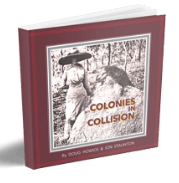If you don’t disturbed the termites much during your discovery.
What’s too much… removal of the damaged timbers, repair of the damaged area or spraying
Termites are shy and even a minor disturbance maybe enough not return to that spot in the near future.
DON’T waste termite bait adding it to timbers that do not contain live termites.
A termite colony can only killed when workers take enough of the termite bait back to the nest. And termites only take termite bait if they can harvest it undisturbed inside the damaged timber.
If you have found termite damage in timbers such as the window/door frames, skirting boards inside, or in studs, posts, roof and foundation timbers of any structure, you need to know if there are live termites.
Here’s how:


Make an opening into the timber using a pointed knife or fine screwdriver.
The hole should be no bigger than about 5mm diameter to begin with. (It can be enlarged when it is time to add the pouch of Colony Killer Termite Bait).
You can pry into the surface of the timber where it feels spongy, thin or hollow or pick away at any of the ‘mud’ termites use to fill up joints cracks or splits in the timber.
Once you have broken through into where it is hollow, wait for a minute or so.
If termites are there, the soldiers usually come to guard the opening while workers repair it. You will see their antennae and their heads blocking the hole.
If no live termites appear, leave the hole open and come back later or check the next day. If termites are still using the timber, the hole will have been repaired and this confirms the termites are ready to be fed the termite bait.
Now you’ll need your Colony Killer Termite Bait.
It has the same active ingredient as is used by professionals. It’s been used for over 20 years and still being used because it does the job right.
Chlorfluazuron inhibits the production of chitin which is the hard outer shell of insects. Also known as an Insect Growth Regulator (IGR). The effect is on the termite nymphs in the nursery area surrounding the queen in a subterranean nest.
The nymphs cannot produce the new shell they need to grow to the next stage and they die… thousands of them. The decomposition gases and the resulting fungi make the termite nest uninhabitable.
The termite queen dies and the workers and soldiers out in the food areas survive for only a few more weeks.
If the timber has a flat surface, make the hole away from corners so you can line it up with the hole in the bottom of the pouch of termite bait.
If the access hole to the termites is on a round post or another situation where the surface is uneven, the flexible pouch will mould into the uneven surface to seal out light and prevent humidity loss as the workers then have direct access into the cache.


You can be more confident of a successful kill using the baiting/feeding method than the dusting or foam introduction methods.
Why?
As one technician explained it: “If termites are harvesting the bait for a few weeks, they are definitely taking it back to their nest; if you use dust or foam and there are no termites in the affected area after a couple of days, it could be they have abandoned the workings because you made it too dusty or too wet or the chemical was too strong.”
There can be another reason (which also applies for the feeding procedure): if anyone does weeding or landscaping or in some other way accidentally severs the underground connection tunnel back to the termite nest—there won’t be any termites visible in the galleries, but it’s not because the nest is dead.
Chlorfluazuron may take longer to kill than the dusts and foams but the nest is just as dead and there is no hazard to people or pets (because we don’t have an outer shell).
As reassurance, once termites begin eating the treatment they don’t usually stop until the colony is dead (or you let them run out of the treatment). What termite bait you don’t use will keep for years.
This bait is not suitable for controlling Mastotermes, the Great Northern Termite. You can easily identify them: they are 13-15mm long, (that’s more than half an inch) and their distribution is generally North of the Tropic of Capricorn.


